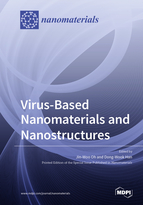Virus-Based Nanomaterials and Nanostructures
A special issue of Nanomaterials (ISSN 2079-4991).
Deadline for manuscript submissions: closed (30 November 2019) | Viewed by 63127
Special Issue Editors
Interests: nanobiomaterials; tissue engineering; regenerative medicine; 3D bioprinting; cells/tissues/organs-on-chips; medical devices
Special Issues, Collections and Topics in MDPI journals
Interests: biosensors and smart health; biomaterials; bioelectronics; bio-engineering; nanomaterials; 3D printing
Special Issues, Collections and Topics in MDPI journals
Special Issue Information
Dear Colleagues,
A virus is considered as a nanoscale organic material that can infect and replicate only inside the living cells of other organisms, from animals and plants to microorganisms, including bacteria and archaea. The structure of viruses consists of two or three parts: (i) the genetic material made from either DNA or RNA, that carry genetic information; (ii) a protein coat, called the capsid, which surrounds and protects the genetic material; and in some cases; and (iii) an envelope of lipids that surrounds the protein coat. By inserting the gene encoding functional proteins into the viral genome, the functional proteins can be genetically displayed on the protein coat to form bioengineered viruses. Therefore, viruses can be depicted as biological nanoparticles with genetically tunable surface chemistry and serve as models for developing virus-like nanoparticles and even nanostructures.
Via such a process, ‘viral display’, bioengineered viruses can be mass-produced with lower cost and potentially applied to tissue regeneration, gene/peptide/drug delivery, theranostics, bio-sensing, and even energy harvesting and storage. In this Special Issue, any type of manuscripts that focus on those biomedical applications, as well as specific approaches and strategies to deal with “Virus-Based Nanomaterials and Nanostructures” will be considered.
We are highly interested in the following topics, including but not limited to:
- virus-decorated nanobiomaterials as scaffolds for tissue engineering
- virus-incorporated hybrid composites for regenerative and translational medicine
- virus-based delivery carriers for gene, siRNA, peptide, antibody, oligomer, drug, etc.
- virus or virus-like nanoparticles for modulating stem cell fate
- virus or virus-like nanoparticles for nanomedicine and theranostics
- virus or virus-like nanoparticles for bioimaging and biosensing
- virus-based nanostructures for energy harvesting and storage devices
Prof. Dr. Dong-Wook Han
Prof. Dr. Jin-Woo Oh
Guest Editors
Manuscript Submission Information
Manuscripts should be submitted online at www.mdpi.com by registering and logging in to this website. Once you are registered, click here to go to the submission form. Manuscripts can be submitted until the deadline. All submissions that pass pre-check are peer-reviewed. Accepted papers will be published continuously in the journal (as soon as accepted) and will be listed together on the special issue website. Research articles, review articles as well as short communications are invited. For planned papers, a title and short abstract (about 100 words) can be sent to the Editorial Office for announcement on this website.
Submitted manuscripts should not have been published previously, nor be under consideration for publication elsewhere (except conference proceedings papers). All manuscripts are thoroughly refereed through a single-blind peer-review process. A guide for authors and other relevant information for submission of manuscripts is available on the Instructions for Authors page. Nanomaterials is an international peer-reviewed open access semimonthly journal published by MDPI.
Please visit the Instructions for Authors page before submitting a manuscript. The Article Processing Charge (APC) for publication in this open access journal is 2900 CHF (Swiss Francs). Submitted papers should be well formatted and use good English. Authors may use MDPI's English editing service prior to publication or during author revisions.
Keywords
- biomedical applications of virus-based nanomaterials
- virus-based nanostructures for energy devices








